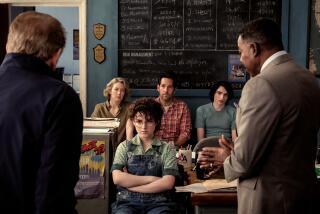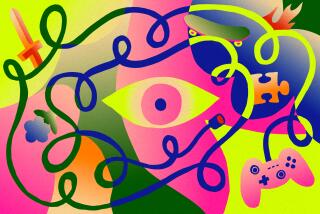Review: ‘Ghosts ’n Goblins Resurrection’ updates everything but the sexist tropes
- Share via
When I first played “Ghosts ’n Goblins” as a kid in the mid-1980s, little me enjoyed the digital squeaks that accompanied every throw of a spear, the zombies that pop out of the cemetery in the first level and, well, I’m not sure if I got much further than that in the game.
My nostalgia for the franchise pretty much stopped there too. I feel no shame for failing to advance. The game itself would essentially express annoyance if players managed to reach the ending, throwing them back to the beginning to do everything all over again. Satan wasn’t actually defeated.
But as a child of the ’80s, whose first vision of all-things-spooky was more or less the video for Michael Jackson’s “Thriller,” the fairy tale-meets-horror mashup of the early levels of “Ghosts ’n Goblins” was enough to make a visual impression — and make me excited to explore its return.
The original “Ghosts ’n Goblins” was instrumental in its early video game exploration of fantasy horror and Western myths, putting players in control of a character who is more or less King Arthur with colorful underpants.
The game is also notorious for being difficult. Creator Tokuro Fujiwara, who has returned to the series this week with the Feb. 25 release of “Ghosts ’n Goblins Resurrection” for the Nintendo Switch, wears difficulty like a badge of pride.
“Ghosts ’n Goblins” was an early leader in a school of video game design that can sometimes shudder at tweaks that impact challenge. It lives on today in a lighthearted manner in games such as “Cuphead” and in the more serious approach of the “Dark Souls” franchise, a series whose intricate medieval horror art style has “Ghosts ’n Goblins” in its DNA. The initial tone of “Ghosts ’n Goblins” was probably intended to be somewhere in the middle — Fujiwara went on to have a pivotal role in the creation of the “Resident Evil” franchise, after all — but rendered silly by the limitations and family-first approach of the Nintendo Entertainment System.
‘Shovel Knight’ was a surprise hit for Yacht Club Games. Now the studio is back with ‘Cyber Shadow.’ It hasn’t entirely changed the formula. But it’s learned some lessons.
“Ghosts ’n Goblins Resurrection” more self-assuredly leans into its storybook influences, with boldly colorful art that looks as appealing as today’s strongest TV animation. The strawberry details in Arthur’s underpants are more visible, and the game now makes clear that they can wield magic (a spell one can unlock allows Arthur to momentarily wield more damage when stripped to his boxers). Its friendly makeover, at least in stylistic tone — jellyfish-like monsters have a neon glow, a magician foe looks more overtly like a circus character, the score has a Ren Faire vibrancy — gives the game an approachable sheen.
Concessions to modern audiences — namely today’s understanding that extreme difficulty can be a form of gatekeeping that keeps people from exploring video games — have been made, even if the game’s options menu prods you away from playing on the easiest mode by joking, “You’re content with only a taste?”
Yes, yes, I am. Competitiveness isn’t what draws me to a game. That’s one thing that hasn’t changed since I was 8. Only today I’m far more curious about exploring the colorfully cartoony demons and Fujiwara’s sadistically humorous approach to game design.
Those looking for a challenge will be pleased that some things never change. What is considered the game’s “normal” difficulty level is more or less impossible for me. Sadly, one other thing that hasn’t changed is the game’s sexist, out-of-date design stereotypes. The story launches once again with a damsel-in-distress plotline: A princess is kidnapped, and Arthur must spring into side-scrolling action.
This plot choice is often an indication of stubbornness, a staunch belief that the story is just an excuse for gameplay. That seems to be true for the run-and-jump approach of “Ghosts ’n Goblins.” But why bother to update pretty much every other facet of the game except the event that launches it? Especially when that event carries so little relevance to the actual adventure?
Of course, this has been a standard trope in games for years. But we’ve at long last seen some attempts to subvert it, such as the flip ending of “Super Mario Odyssey” where Princess Peach rejects Mario’s hand to go off and have her own adventures.
Here, though, the cliched, flimsy story is a shame. That’s because there were plenty of moments “Ghosts ’n Goblins Resurrection” had me smiling.
‘Little Nightmares 2’ revels in the kind of childhood fears that never go away, and in turn provides life lessons amid its playful, grotesque world.
Often, it seemed that little Arthur was essentially running around on a track inside a piano as someone played the most complex concerto imaginable. Strings, bars and environmental noise were constantly being thrown at me. Fujiwara and his team utilized tattooed pigs, dragons made of stone, giant spindles and big cats with fire for fur as instruments. The deeper one gets, it becomes apparent there’s a real joy in this tricky little throwback adventure.
Many of the monsters will be familiar to longtime fans of the series, but I most enjoyed the level that appears to be shot from inside a creature’s mouth. While I assume this was a nod to Monstro from “Pinocchio,” I was, quite frankly, charmed at the mental math it inspired me to make, as I wondered why the beast just didn’t bite down or what it thought of my inability to avoid running into guillotines fashioned out of skulls that are thrown all over this universe.
Maybe I simply wasn’t worthy of being prey.
But I persevered and, thanks to the game’s never-really-die easy mode, accomplished something the elementary-school version of me failed at: I got deep into a “Ghosts ’n Goblins” game. While hardcore players will likely look down on the way I stripped it of its mightiest challenges, I did so for good reason: The beauty of games isn’t the level of difficulty they offer but the imagination they inspire.
More to Read
The biggest entertainment stories
Get our big stories about Hollywood, film, television, music, arts, culture and more right in your inbox as soon as they publish.
You may occasionally receive promotional content from the Los Angeles Times.











